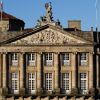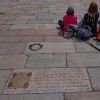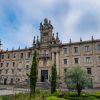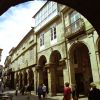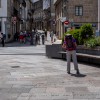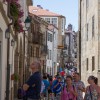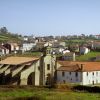- Accede I
- Regístrate I
- carrito
02. Plaza del Obradoiro
02. Plaza del Obradoiro
Galería de imágenes

La Plaza del Obradoiro es el centro monumental de Santiago de Compostela.
Esta plaza resume la historia milenaria de la ciudad. En ella encontramos la síntesis de los cuatro símbolos y puntos cardinales de la vida de Santiago y Galicia. En el Este, la Iglesia, representada por la imponente catedral. En frente, el gobierno municipal de Santiago de Compostela con el Palacio de Rajoy. En el Sur, la Universidad, cuyo rectorado ocupa el colegio de San Jerónimo. Y finalmente, en el Norte, el Hostal de los Reyes Católicos, hoy Parador Nacional, símbolo de la hospitalidad que la ciudad brinda a la peregrinación.
El nombre de la plaza nace de los ‘obradoiros’ o talleres de los canteros que trabajaron en este lugar durante la construcción de la fachada barroca de la Catedral, utilizando el amplio espacio para almacenar los materiales para su edificación.
Un giro de 360 grados permite reconocer a simple vista la presencia de distintos estilos arquitectónicos, surgidos en más de 700 años de construcción. Barroco en la fachada de la Catedral, neoclásico en el Palacio de Rajoy, gótico de transición en el Hostal y renacentista en San Jerónimo. Pero lejos de desentonar, consiguen una gran armonía, que emana probablemente de la utilización del granito, este sólido material que ha dado a esta plaza el carácter de obra eterna, a pesar del continuo lavado de la lluvia.
Antes de centrar nuestra atención en la Catedral, repasemos por un momento las demás construcciones de la plaza. El edificio más pequeño, en el lado sur, pertenece a la Universidad de Santiago de Compostela, que ha marcado la vida cultural de la ciudad durante los últimos 500 años. Su rectorado ocupa el renacentista Colegio de San Jerónimo. Fundado en el siglo XVI para albergar a estudiantes pobres de Artes, muestra a la Plaza del Obradoiro un portal tardo-gótico que perteneció originalmente a un hospital de peregrinos.
Frente a la fachada occidental de la Catedral se levanta el monumental Palacio de Rajoy. Este edificio neoclásico, que en principio estaba destinado a ser seminario de confesores, además de cárcel civil y eclesiástica, hoy es sede de los gobiernos de la ciudad y de la comunidad autónoma, representados, respectivamente, por el Ayuntamiento de Santiago de Compostela y la Presidencia de la Xunta de Galicia. Su tímpano está decorado con un relieve de la Batalla de Clavijo, aquella primera contienda en la que, según la leyenda, se apareció a los reyes cristianos la figura del Apóstol guerrero, para ayudarles a combatir la invasión del Islam.
De hecho, en todos los edificios de la plaza del Obradoiro está representada la figura del Apóstol, aunque de distintas formas. Como guerrero montado en su caballo blanco en esta fachada del Palacio de Rajoy. Como santo peregrino en la fachada de la catedral y en el colegio de San Jerónimo. Y en el hostal aparece dos veces: como apóstol en el friso, y con vieira y bastón de caminante en la parte superior.
El pavimento, pese a su aspecto antiguo, fue quizás la última adquisición de esta plaza, que hasta bien entrado el siglo XX solo poseía los pasillos radiales en forma de estrella por los que caminaba la gente para evitar el barro. En el punto donde confluyen, se halla una modesta placa, considerada por los peregrinos su kilómetro cero, el punto de llegada de todos los caminos que conducen al Apóstol. Si nos acercamos, leeremos en ella que el Consejo de Europa declara en 1987 al Camino de Santiago “Primer Itinerario Cultural Europeo”.
Esta distinción viene a sumarse a la declaración de la UNESCO, que reconoció a la ciudad como Patrimonio de la Humanidad en 1985, y a los numerosos galardones que acumula Santiago de Compostela gracias a la conservación de su patrimonio y su habitabilidad.











